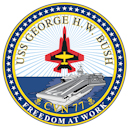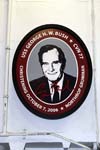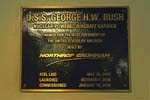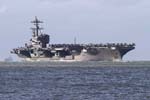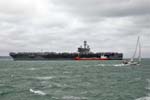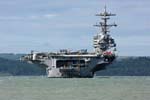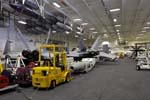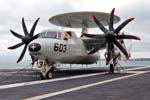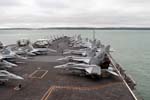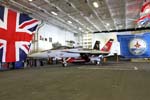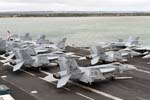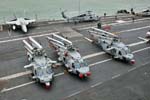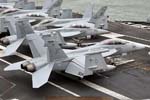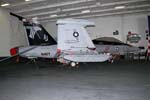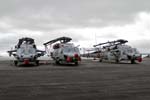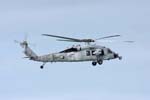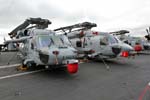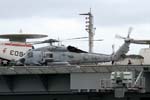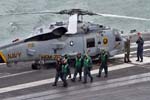|
|||||
| Author:
Robin Powney Photography: Paul Tiller & Author |
|||||
|
Construction of the US Navy’s latest and greatest tool of diplomacy began back in September 2003 when her keel was laid at the birthplace of all Nimitz-class aircraft carriers, Northrop-Grumman’s Newport News Shipyard in Virginia. Six years, 47,000 tons of steel, 250 miles of piping and $6.2 billion later, the Navy had their tenth and final Nimitz-class flattop – CVN-77. Named for the 41st President of the United States, one George Herbert Walker Bush, she also goes by the nickname of The Avenger which stems from the torpedo bombers he flew from the deck of CVL-43 USS San Jacinto in back in World War II. |
||||
With the exception of CVN-76 USS Ronald Reagan, CVN-77 looks quite different to the rest of the Nimitz-class. The reasons being both have significantly different “islands” (the command centre for flight-deck operations, as well as the ship as a whole) from the rest of the class; these have a new mainmast and various antennae have been rearranged. For instance, just twenty-one sensor/comms antennae replace eighty-three on the earlier design and, most obviously, the separate mast is now incorporated into just the one structure. She also features different jet blast deflectors that use ceramic tiles, a reduced radar signature and a new hangar bay designed to be more space efficient. Prior to the induction of CVN-78 USS Gerald R. Ford in about 2015, The Avenger is as good as it gets for an aircraft carrier. |
|
Commissioned on 10 January 2009, she was formally accepted by the Navy on 11 May 2009 and her first catapult launch was a VX-23 F/A-18F Super Hornet on 19 May 2009. She received her flight deck certification just one week after that first cat shot, on 26 May 2009. Later that year, on 3 September 2010, ammunition was transferred from CVN-69 USS Dwight D. Eisenhower and T-AKE-5 USNS Robert E. Perry and three weeks later, CVW-8 officially embarked for the first time. She wouldn’t be going on her maiden deployment without a bit of practice and the strike group, with P-3Cs from VP-10 and VP-45, sank T-AFS-10 USNS Saturn as part of a SINKEX in late October 2010. |
Almost exactly two years after her acceptance and under the command of Captain Brian “Lex” Luther, CVN-77 left her home port of NS Norfolk on 11 May 2011 for her maiden combat deployment. She would then take up her role as flagship for Carrier Strike Group TWO (COMCARSTRKGRU TWO) which would be commanded by Rear Admiral Nora W. Tyson, the first woman to ever command a carrier strike group, and the underway home for Carrier Air Wing EIGHT (CVW-8). Carrier Strike Group TWO consists of CVN-77 USS George H. W. Bush with CVW-8 embarked, CG-64 USS Gettysburg, CG-68 USS Anzio, Destroyer Squadron TWO TWO’s DDG-57 USS Mitscher and DDG-103 USS Truxton and, for a short while, the Spanish Navy’s F102 ESPS Amirante Juan de Borbon. It wasn’t just the maiden deployment for CVN-77 as DDG-103 was also on her maiden deployment too, having only been commissioned herself in 2009. The air wing embarked aboard CVN-77 was the same one as that embarked aboard CVN-71 USS Theodore Roosevelt for the last visit of a US carrier to UK waters in 2009. |
|
|
This maiden deployment would see her heading to the 5th Fleet Area of Operations to relieve CVN-65 USS Enterprise but it would also initially include participation in SAXON WARRIOR 11, a Royal Navy led exercise held between 19-26 May involving the UK, US, France, Spain, Germany, Canada and Sweden in the South Western Approaches and Western English Channel. Aircraft of CVW-8 would join RAF and other NATO assets and operate over the UK. Following this exercise, both CVN-77 and DDG-103 would, for the first time, make a port call outside of the US; CVN-77 dropped anchor in Stokes Bay whilst DDG-103 pulled up dockside in Portsmouth harbour. |
CVW-8, comprising of VFA-31 Tomcatters, VFA-213 Black Lions, VFA-15 Valions, VFA-87 Golden Warriors, VAQ-141 Shadowhawks, VAW-124 Bear Aces, HSC-9 Tridents, HSM-70 Spartans and a VRC-40 Rawhides detachment looks pretty much the same as it did back in 2009 with the only obvious change being HSC-9 (who were HS-3) and the inclusion of HSM-70. However, though VFA-31, VFA-213, VFA-15, VFA-87, VAW-124 and VRC-40 were still flying pretty much exactly the same aircraft they were back in 2009; VAQ-141, HSC-9 and HSM-70 were undertaking cruises with new equipment and, to some extent, new roles to fulfil. |
|
|
VAQ-141 Shadowhawks are the second operational unit to transition from the EA-6B Prowler to the EA-18G Growler and began their transition back in June 2009, shortly after returning from their 2009 cruise, achieving “safe for flight” with the Growler in February 2010. Though VAQ-132 Scorpions were the first to transition onto the new platform, VAQ-141 has the honour of being the first Growler unit to deploy as part of a carrier air wing. They won’t, however, get to be the first to take the Growler into combat as VAQ-132 forward deployed their five Growlers to somewhere in Iraq which were subsequently redeployed, less than 48 hours after recovering from Iraq operations, to Aviano AB for operations over Libya in support of Operation ODYSSEY DAWN. |
The Growler will completely replace the EA-6B in the airborne electronic attack role by 2014 and is, essentially, a Block II F/A-18F Super Hornet featuring the Improved Capability (ICAP) III system from the EA-6B. Though looking like the F/A-18F, it does feature a few external additions such as the AN/ALQ-218 receiver pods on the wingtip rails. It also carries up to five AN/ALQ-99 tactical jamming pods, the same as those carried by the EA-6B, and can employ AGM-88 HARM missiles. Unlike the EA-6B, it is also fitted with a tactical Interference Cancellation (INCANS) system which means the EA-18G can conduct voice communications with friendly forces whilst simultaneously jamming enemy radio communications. Furthermore, Admiral Gary Roughead is on record as being pleased with the performance of the EA-18G over Libya. Incidentally, the name Growler sounds pretty similar to Prowler so, as far as flight deck ops go, the Growler will have the nickname of “Grizzly”. |
|
|
HS-3 Tridents also began a transition process in June following their CVN-71 cruise which saw them change homeport from NAS Jacksonville to NAS Norfolk, re-designated as HSC-9 and swap their SH-60F/HH-60H Seahawks for the MH-60S Knighthawk. The Tridents gave away their SH-60F/HH-60Hs to other Jacksonville based units whilst also sending some off to storage in AMARG at Davis Monthan AFB in Arizona. Designed to perform vertical replenishment, special warfare support, combat search and rescue, airborne mine countermeasures and, when armed, anti-surface warfare, the MH-60S covers the roles performed by SH-60F/HH-60Hs (with the exception of anti-submarine warfare) and with a complement of eight helicopters, six are deployed aboard CVN-77 whilst the remaining two are deployed aboard the supply ship. An interesting item of note is that the MH-60Ss but are in fact UH-60L/SH-60B hybrids that use the UH-60L airframe for more cabin space and double doors with what are basically SH-60B mechanicals for naval operations. |
HSM-70 Spartans have a couple of firsts of their own too – not only are they the first East Coast unit to fly the new MH-60R Seahawk, they are also the first unit to deploy it aboard a carrier. The MH-60R is one of the world’s most advanced and capable naval helicopters and will eventually replace all SH-60Bs and SH-60Fs. Amongst other changes, it is fitted with an AN/APS-147 radar which is an improvement over the AN/APS-143 OceanEye fitted on SH-60Bs and, like the SH-60B before it, its primary missions are anti-submarine and anti-surface warfare. For these missions, it can be armed with Mk 54 Lightweight Hybrid Torpedoes and AGM-114 Hellfire missiles. As they have replaced SH-60Bs, the HSM-70 MH-60Rs are deployed aboard most of the strike group escort ships such as DDG-103 and a number are embarked aboard CVN-77. |
|
The rest of the airwing was identical, even down to specific aircraft, although the paint jobs tail paint schemes have changed somewhat. At the top of the tree for superb artwork on their CAG bird were VFA-31 Tomcatters – the tail art on Felix 100 was a work of true beauty. Running it close was Outlaw 500, the rather stunning VAQ-141 CAG bird. Sadly, both these gems were sat in the hangar following the reception of a number of VIPs/distinguished visitors. The Black Lions hadn’t really changed the design of Lion 200 but it did now include MUTHA stencilling following their winning of the coveted award – although Tanuki, the central figure, has since been ‘acquired’ through less than official means by VFA-102 Diamondbacks. |
Following her stay in Portsmouth, she CVN-77 undertook her first deployment replenishment at sea on 4th June and, during the four hour operation, took 1.2 million gallons of fuel in a CONREP with T-AO-195 USNS Leroy Grumman and 32,000lb of food, parts and mail spread amongst 217 pallets from T-AKE-2 USNS Sacagawea in a VERTREP with two HSC-9 MH-60Ss. Just one day later she passed through the Straits of Gibraltar, into the Mediterranean and prepared for another port call; her first in mainland Europe, at Cartagena, Spain on 6th June. Pulling out of Cartagena two days later, she would head further east before a third liberty call, this time briefly calling in on Naples, Italy on 11th June. With Naples being home to a US naval base, this third and final European “pre-deployment” liberty would provide some degree of familiarity for her crew before finally entering into 5th Fleet’s Area of Responsibility where she will be supporting on-going operations in the region. |
The
author would like to thank LTjg Adam Meerkat Moseley and the crew of CVN-77 who did their best to make this visit, during their liberty call, enjoyable, informative and go smoothly without a hitch. Good luck guys and stay safe! We’d also like to extend our gratitude and appreciation to Chris Berry. |

